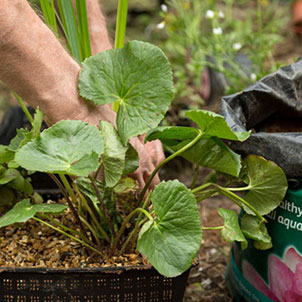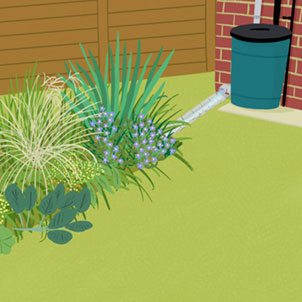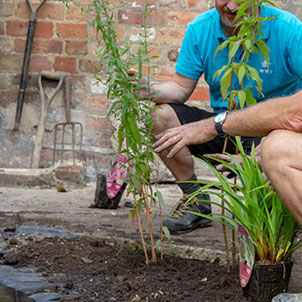Invasive garden plant species
Which are the most damaging invasive plants to look out for?
Although a pond or mini wetland is a fantastic addition to any garden, if not cared for properly, some pond plants can take over and can cause untold damage if they’re allowed to escape into the wild. Garden ponds are particularly vulnerable as people often inherit invasive plants or transfer them accidentally from other ponds.
But how damaging could a ‘water lettuce’ be? Or a ‘skunk cabbage’? The answer is very. It’s estimated that invasive and non-native species cost the British economy at least £1.7bn per year. Non-native invasive wetland plants can spread rapidly and outcompete native plants, clog our waterways and lead to an increase in flooding. They can also remove oxygen, killing local wildlife. Seeds and fragments of these plants can be transported by water throughout the whole river catchment or floodplain and once in, they’re extremely hard to get rid of.
Why are invasive species a problem?
We’ve listed some of the most problematic plants below so you can keep an eye out for them in your garden or when you’re out and about near wetlands, but this information is intended as a quick ID guide rather than a manual.
Found an invasive species you think might be a problem and don't know what to do? The INNSS website has more information on reporting an invasive species. Plantlife have lots of information on what to do if you're considering removing something. We’ve also provided suggestions of alternative native plants you can use for your ponds at home.
Thank you for helping wetlands! Just remember when removing invasive species yourself – compost with care and check, clean and dry your equipment after use so that you don’t accidentally spread them into the wild.
Banned plants
None of these plants are legally for sale in the UK and it's an offence to plant them into the wild. But that's not to say they're not out there - far from it!
Parrot’s feather
Myriophyllum aquaticum (also known as Brazilian water milfoil and myrdd-ddail in welsh)
- Threat: Can cause flooding by blocking watercourses and drainage channels. Rapidly takes over a water body, displacing native species.Still occasionally seen in garden centres as Brazilian water-milfoil and Myrdd-ddail (Welsh) but is banned from sale. It spreads through improper disposal of garden and aquarium plants.
- How to spot: It changes forms depending on whether it is submerged or emerging from the water. Look for stiff, bright green leaves emerging and small white flowers from May to August. Similar looking species are water-milfoil, Mares Tail, hornwort and fanwort. Water milfoil species are never emergent except for short flower spikes.
- Remove it: Cut and dredge small areas if possible, and pull out stems by hand. Remove cut material from the water as soon as possible and repeat as necessary throughout the summer months.
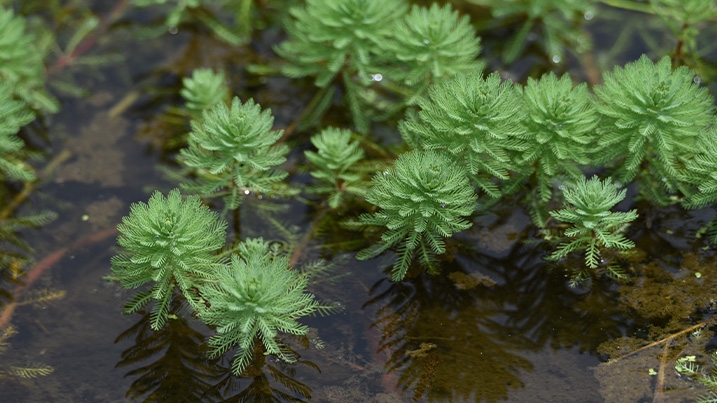
Water fern
Azolla filiculoides (also known as Fairy Fern, Cyfrdwy)
- Threat: Out-competes native species by blocking out light and oxygen. A danger to children, pets and livestock who may try to walk onto the apparently dry land without realising there’s deep water beneath.
- How to spot: Lives in still and slow-flowing water bodies. Forms very dense mats. Usually green but can be tinged red, especially when exposed to physical stresses. Can inadvertently be carried on plants from garden centres.
- Remove it: Scoop with a net, repeated clearing is necessary due to spore release once dense mats have formed.
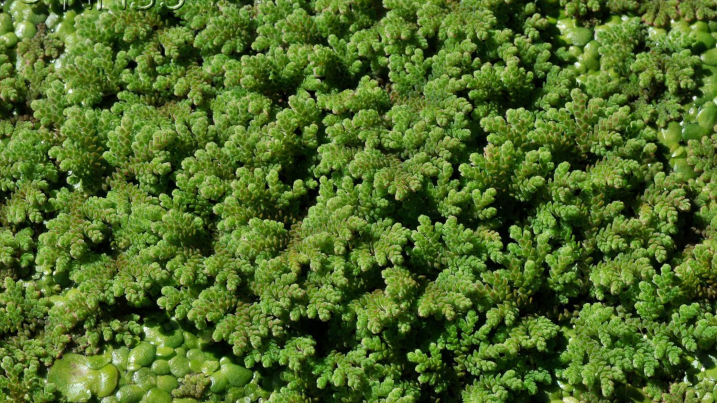
Water primrose
Ludwigia grandiflora
- Threat: Since its introduction as an ornamental water plant, its rampant growth out competes native species, clogging waterways and contributing to flooding.
- How to spot: It’s quite easy to spot when it’s floating, but when it’s growing at the edge of wetlands it’s harder to pinpoint. It flowers in July and August so this is the best time to check for it.
- Remove it: Thin with a rake if possible, and pull out stems by hand. Remove cut material from the water as soon as possible and repeat as necessary throughout the summer months. Early intervention really helps control it.
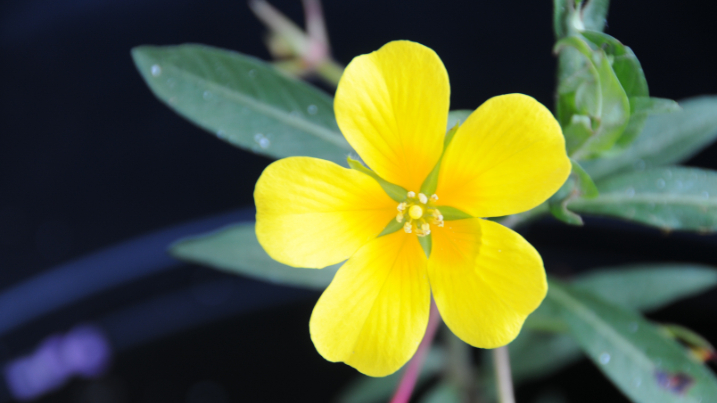
Floating pennywort
Hydrocotyle ranunculoides (floating marsh pennywort)
- Threat: Causes a range of problems including changing the availability of oxygen in the water, threatening fish and insects, choking drainage systems and crowding out native water plants.It was first established in the wild in the south and east of England, and appears to be travelling north and westwards.
- How to spot: It likes still or slow-flowing water, seasonally flooded wetlands and shallow ponds or lakes. It has shiny, green, crinkle-edged leaves and a fleshy stalk.
- Remove it: This plant is extremely rapid growing and can re-grow from a small fragment. Pulling the stems after cutting to reduce regrowth. Remove cut material from the water as soon as possible and repeat as necessary throughout the summer months.
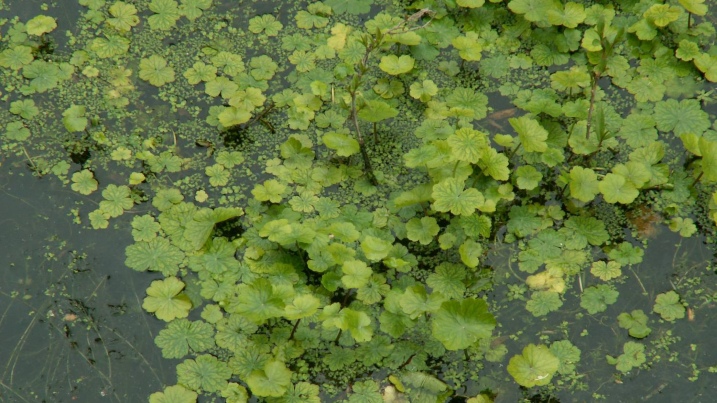
New Zealand pygmyweed
Crassula helmsii
- Threat: Forms dense mats and can prevent drainage, causing flooding. Displaces other wetland plants.Invasive throughout most of England and concentrated in the south-east.
- How to spot: The leaves are a pale yellow-green and grow opposite one another, around 2cm long. The leaves are fleshy and the small flower is pink. You might find it totally submerged, on-land or emerging.
- Remove it: It's extremely hard! Pull it out. This plant can grow from very tiny fragments, so remember to check your equipment and shoes. At Llanelli wetland centre, we've been trying unconventional methods in a bid to slow the spread of the mighty Crassula.
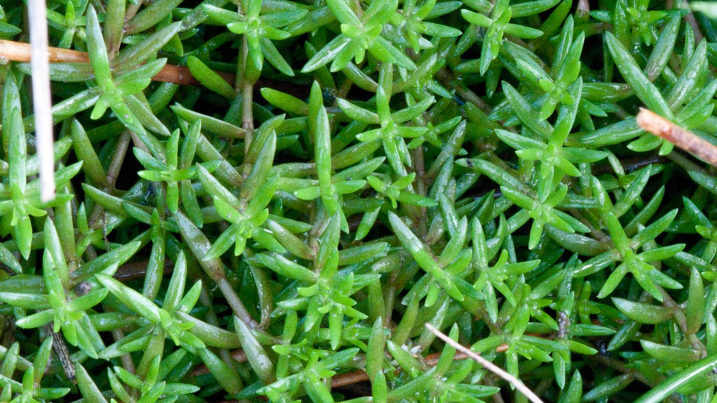
Himalayan balsam
Impatiens glandulifera (or Indian balsam)
- Threat: Exploding seedpods and waterproof seeds make this plant very good at colonising huge areas of wet habitat at the expense of other species. Can cause bank erosion and flooding in some areas as dies back in winter providing no protection against rising water levels.
- How to spot: Unfortunately Himalayan balsam is very attractive, with pink-purple flower heads and tall stems, so it is sometimes still favoured by gardeners. You might spot it among urban rivers or other water bodies, as it likes the damp. Orange balsam is very similar, and equally invasive.
- Remove it: Due to the plant’s shallow roots, you can dig it up easily, then cut it back and suppress its growth using leaf mulch. Himalayan balsam is an annual, so if you see it out and about, pull it up before the seeds are fully formed - it's an easy way to help protect our biodiversity.
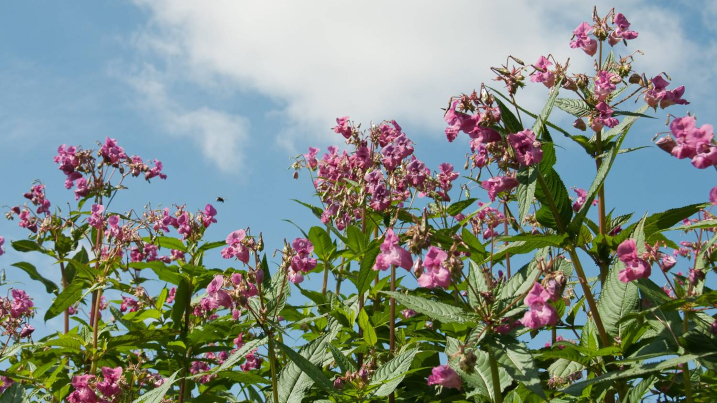
American skunk cabbage
Lysichiton americanus
- Threat: When planted as an ornamental beside ponds and swampy streams it can easily escape into the wild to the detriment of native plants. In the New Forest it has become so dominant that in some sites it is has eradicated almost all native flowers like bluebell and wood anemone.
- How to spot: Large yellow flowers bloom in spring, they look a little like those of wild arum/lords-and-ladies. You can’t miss the smell, it’s a very strong odour. Look out for it in wet woodland.
- Remove it: Due to the plant’s shallow roots, you can dig it up easily, then cut it back and suppress its growth using leaf mulch.
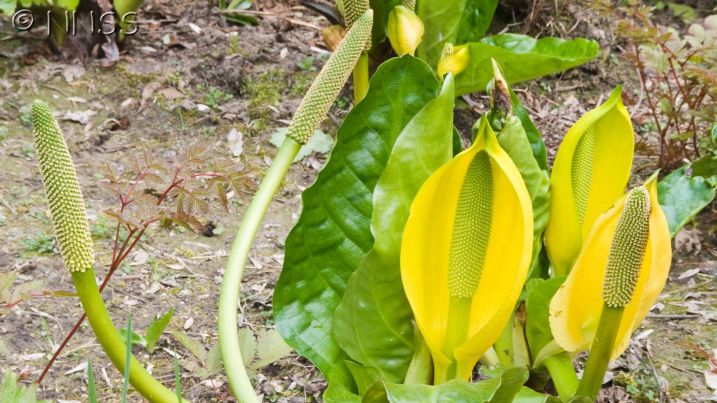
Common water hyacinth
Eichhornia crassipes
- Threat: Native to the Amazon basin, in tropical regions it can cover vast expanses of water, blocking light and stopping the movement of animals causing massive economic, ecological and social impacts.
- How to spot: Has a spongy leaf and stem to float on top of the water, and light purple flowers with blue and yellow marks on the upper leaves.
- Remove it: Although widely regarded as the world’s most troublesome invasive plant in frost-free areas, it’s not currently regarded as invasive in the UK, but could become more of an issue with a warming climate.
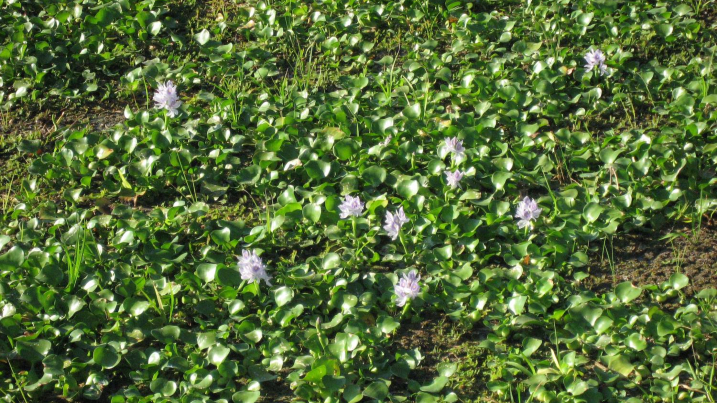
Cabomba
Cambomba caroliniana
- Threat: It is highly competitive and forms dense mats that can block out sunlight, damaging other submerged plants, killing fish and obstructing movement of animals.
- How to spot: It grows green, frondy leaves off long stems with occasional white flowers about the surface.
- Remove it: Prevention is best here: do not let it escape into the wild from aquariums and be aware that fragments of stems can lead to new plant growth, not just the leaves. If you see it, report it.
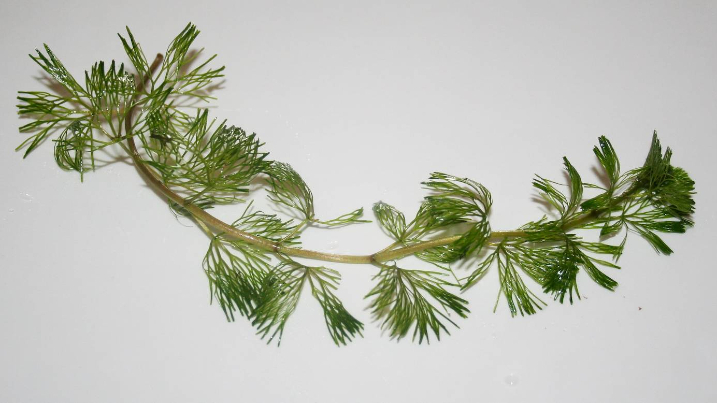
Ones to watch out for: still found in garden centres
Waterweed species
e.g. Canadian waterweed, curly waterweed, Nuttall’s waterweed, Cape pondweed
- Threat: Created a major issue in the New River in North London where large volumes of weed blocked screens and tonnes had to be removed by hand on a daily basis. It can grow to up to three metres in length.
- How to spot: This weed is problematic for gardeners as it’s widely sold in garden centres simply labelled as ‘pondweed’.
- Remove it: Carefully pull it out. This process will probably need to be repeated over a few years.
- Alternative: Rigid hornwort is a native oxygenating plant that can be used instead.
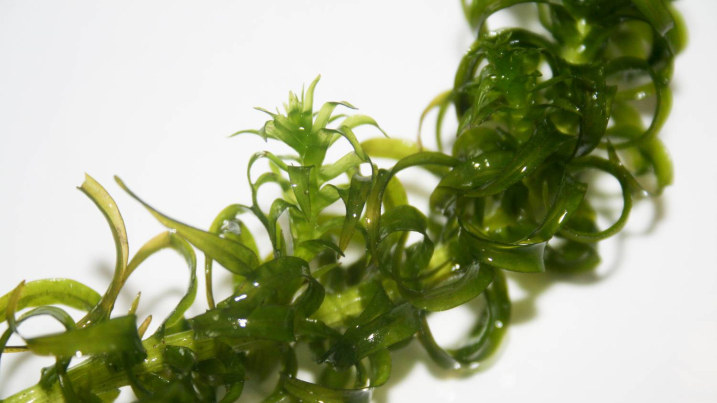
Duck potato
Sagittaria latifolia
- Threat: First recorded in the UK in 1941 but is spreading in lakes, ponds, streams and rivers where it competes with similar native plants like water plantain. It escapes easily from ponds into our wild waterways and seems to be increasing. You can still buy it from garden centres.
- How to spot:It has distinctive heart-shaped leaves and three-petalled white flowers. It produces tubers, stolen and seeds, which help it to spread into the wild.
- Alternative:Native water plantain or Sagittaria sagittifolia - the latter is less impressive but still a lovely plant, but you have to be careful that this is what you are getting and not latifolia!
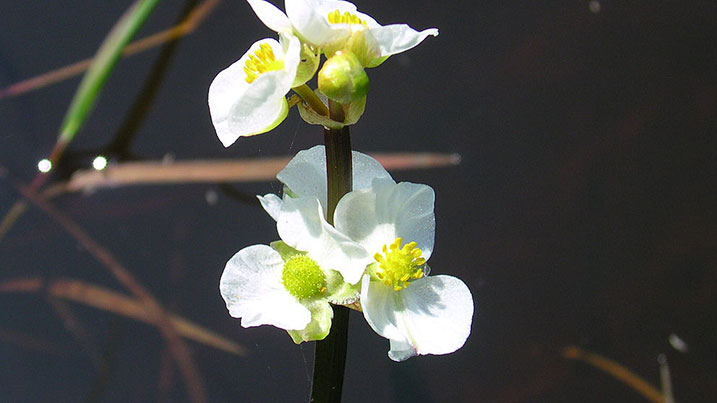
Giant rhubarb
Gunnera species
- Threat: A native of South America it was introduced into Europe as an ornamental but has since escaped into the wild where it invades streams, riverbanks, lakes and ponds. It can block drains and cause soil erosion. It has even been known to out-compete willow trees.
- How to spot: The huge leaves and spiky stems are unmistakeable - when it grows in clusters, it blocks out the light for other plants. It's also still very popular in private gardens, so you may recognise it from this context.
- Remove it: Free the plant from the soil, taking care not to break the stems. Dig as far as you can around the base of the plant to remove as much of the root as possible. Alternatively cut the flower heads close to the base in July-August to stop the plant from sowing seeds.
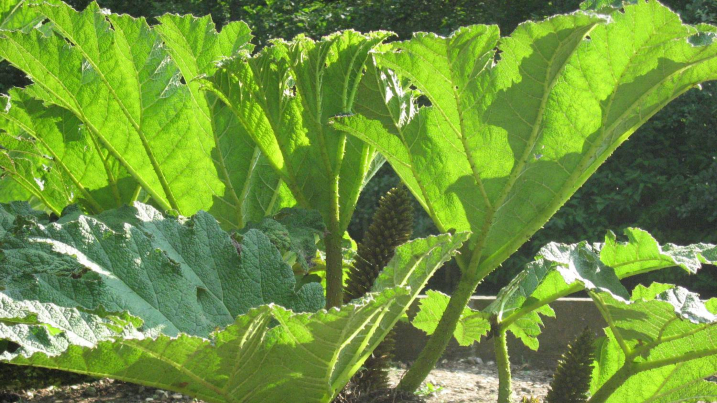
Water lettuce
Pistia stratiotes
- Threat: Quickly forms dense floating mats which block waterways, hinder navigation and prevent water flow causing flooding. Can also harm natural ecosystems by lowering oxygen levels and preventing air-breathing aquatic insects from reaching the surface. At the moment, it can only survive in warmer temperatures, but if our climate continues to warm it could pose a bigger problem.
- How to spot: Looks like a small lettuce growing on the surface of the water.
- Remove it: Use a rake or skimming tool to remove from your pond several times a year.
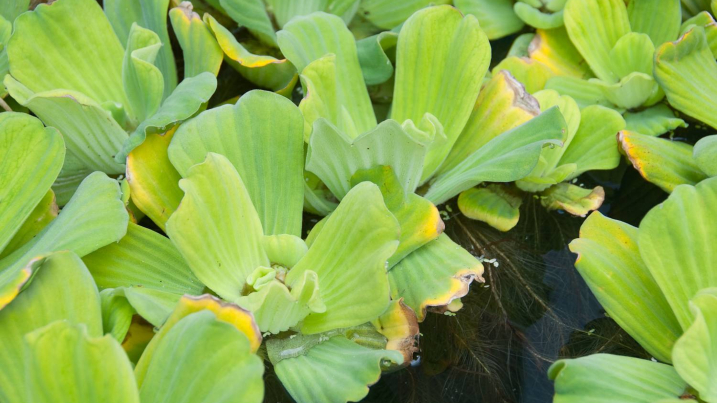
More information
The above list is intended as a brief guide for some of the more common invasive species you might come across in your local wetland. For more detailed information, the GBNNSS has ID cards for each of the above species to help you in your identification, and Plantlife have a downloadable PDF guide.
Find out more about how to dispose of your unwanted garden plants safely and securely.
